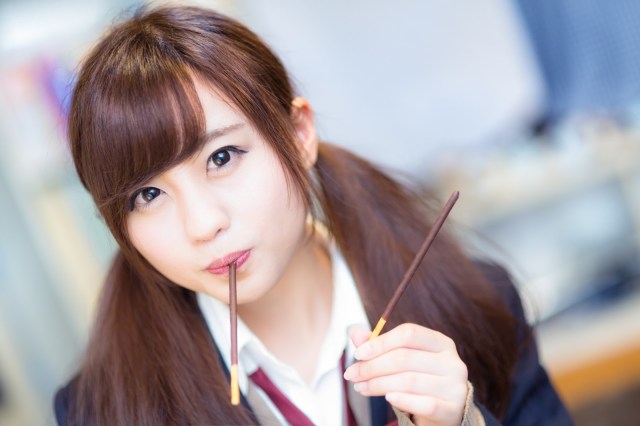
Some people in Japan just don’t want to part ways with individually wrapped candy.
If you’ve ever enjoyed a rice cracker or biscuit from Japan, you’ve probably marvelled at the subtle flavour, the delicate attention to detail…and all the extra plastic packaging. That’s because a large majority of multi-pack snacks come individually wrapped, largely catering to Japan’s custom of buying edible omiyage (souvenir) gifts for work colleagues to share after a trip away.
While it may feel nice to give and receive individually wrapped morsels, all that extra plastic isn’t doing Mother Nature any favours. However, Mother Nature has found an ally in a Japanese private high school student in Tokyo, who recently decided to make a change by starting a petition to end excessive plastic packaging.
The 16-year-old student called out chocolate maker Bourbon and Kameda Seika, a leading rice cracker manufacturer, as the biggest culprits, saying the excess waste came to her attention after she and her family ate an increased number of their products while staying at home during the coronavirus pandemic.
▼ Bourbon’s lineup of popular biscuits are all individually packaged.
The student says she was sorting out the plastic recycling with her mother one day when she was shocked to see the amount of plastic food packaging their family of five went through. After sorting the plastic waste, more reappeared the next day, and after reading about the environmental problems it could cause, especially to oceans and marine life, she decided to start a Change.org petition aimed at the two snack brands.
▼ The plastic waste from a pack of Kameda Seika’s Happy Turn crackers.
https://www.instagram.com/p/B2WdGJ-jjGu/?igshid=1ii8fhsrni0yn
The petition asking the two brands to put an end to excess plastic packaging was posted on 13 May and has since received over 18,400 signatures as of this writing. Despite the overwhelming support, however, the student still received backlash from people quite happy to keep with old habits.
“My grandmother likes to give these to visitors so the individual wrapping is convenient for her when she has guests over.”
“Older people don’t eat as many snacks as younger people so they don’t waste as much packaging.”
“It keeps the food safe and it’s hygienic, what’s not to like?”
“If the plastic tray insert is removed, the crackers will crack — is that what you want?”
“She’s probably too young to know about the Glico Morinaga incident.”
The Glico Morinaga incident refers to an unsolved extortion case affecting confectionery brands Glico and Morinaga from 1984 to 1985. The culprit claimed to have laced Glico confections with potassium cyanide, causing the company to pull products from sale, costing them millions of dollars.
To this day, many people believe the individual packaging used in Japanese snack products is a direct result of this incident. However, that theory has been debunked by a number of researchers, who point out that while products were initially packaged in extra thick plastic as a precautionary measure after the incident, the thin plastic used nowadays provides no protection against being pierced with poisoned syringes.
While the debate around plastic packaging heats up in Japan, the student who started the petition will be presenting the signatures to Bourbon and Kameda Seika on 28 and 29 July. Environmental issues and ideas for future packaging will be discussed at the meeting.
According to a spokeperson at Kameida Seika, the company agrees that they should reduce plastic waste and are currently promoting new packaging that doesn’t include the flat plastic tray insert. A spokesperson at Bourbon says they aim to switch over to plant-based “plastics” in future.
It’s good to see the conversation around plastic waste is having its time in the limelight in Japan, thanks to a high school student from Tokyo. Perhaps big confectionery manufacturers can now make moves to follow in the footsteps of Nestle, who switched to paper packets for KitKats that can be recycled into origami cranes.
Or maybe they can simply make more use of boxes that can be turned into stunning works of art by crafty individuals.
Sources: Yahoo! News (1, 2) Jin (1, 2), Change.org
Featured image: Pakutaso
● Want to hear about SoraNews24’s latest articles as soon as they’re published? Follow us on Facebook and Twitter!

 Want to boost your ego? Head to the new Homeru “Praise” Bar in Osaka
Want to boost your ego? Head to the new Homeru “Praise” Bar in Osaka Cafe in Tokyo serves custom 2-D and 3-D latte art, and their coffee is nothing to sniff at either
Cafe in Tokyo serves custom 2-D and 3-D latte art, and their coffee is nothing to sniff at either Edible fireworks? Japanese confectioner creates incredible sweets out of super-soft mochi【Photos】
Edible fireworks? Japanese confectioner creates incredible sweets out of super-soft mochi【Photos】 Reebok teams up with fashion brand Yoshiokubo for traditional-culture-inspired sneakers
Reebok teams up with fashion brand Yoshiokubo for traditional-culture-inspired sneakers Survey ranks Japanese prefectures by how much people want to continue living there
Survey ranks Japanese prefectures by how much people want to continue living there How to order snacks on a Shinkansen bullet train in Japan
How to order snacks on a Shinkansen bullet train in Japan Burger King Japan suddenly adds Dr. Pepper and Dr. Pepper floats to its menu nationwide
Burger King Japan suddenly adds Dr. Pepper and Dr. Pepper floats to its menu nationwide New Nintendo Lego kit is a beautiful piece of moving pixel art of Mario and Yoshi【Photos】
New Nintendo Lego kit is a beautiful piece of moving pixel art of Mario and Yoshi【Photos】 Hello, cosmetics! Clinique teams up with Hello Kitty this summer for first-time collaboration
Hello, cosmetics! Clinique teams up with Hello Kitty this summer for first-time collaboration Demon Slayer: Kimetsu no Yaiba gets new roller coaster attractions and food at Universal Studios Japan
Demon Slayer: Kimetsu no Yaiba gets new roller coaster attractions and food at Universal Studios Japan 11 different ways to say “father” in Japanese
11 different ways to say “father” in Japanese Kyoto tea merchant’s matcha parfait ice cream bars: The desserts we’ve been waiting 187 years for
Kyoto tea merchant’s matcha parfait ice cream bars: The desserts we’ve been waiting 187 years for East meets West in the Pacific-centered version of the world map
East meets West in the Pacific-centered version of the world map What do you eat when you catch a cold? We asked 11 of our Japanese reporters
What do you eat when you catch a cold? We asked 11 of our Japanese reporters Shinjuku izakaya’s all-you-can-eat-and-drink plan is one of Tokyo’s best secret cheap eats
Shinjuku izakaya’s all-you-can-eat-and-drink plan is one of Tokyo’s best secret cheap eats Nintendo history you can feel – Super NES, N64, and GameCube controllers become capsule toys
Nintendo history you can feel – Super NES, N64, and GameCube controllers become capsule toys “The most Delicious Cup Noodle in history” – Japan’s French Cup Noodle wins our heart【Taste test】
“The most Delicious Cup Noodle in history” – Japan’s French Cup Noodle wins our heart【Taste test】 Starbucks releases a cute Frappuccino and Unicorn Cake…but not in Japan
Starbucks releases a cute Frappuccino and Unicorn Cake…but not in Japan Kyoto Tower mascot termination reveals dark side behind cute Japanese characters
Kyoto Tower mascot termination reveals dark side behind cute Japanese characters McDonald’s Japan’s Soft Twist Tower: A phantom ice cream only sold at select branches
McDonald’s Japan’s Soft Twist Tower: A phantom ice cream only sold at select branches Yabai Ramen: What makes this Japanese ramen so dangerous?
Yabai Ramen: What makes this Japanese ramen so dangerous? Finally! Nintendo Japan expands Switch 8-bit controller sales to everybody, Online member or not
Finally! Nintendo Japan expands Switch 8-bit controller sales to everybody, Online member or not Japanese government wants to build luxury resorts in all national parks for foreign tourists
Japanese government wants to build luxury resorts in all national parks for foreign tourists To combat declining birth rate, Japan to begin offering “Breeding Visas” to foreigners
To combat declining birth rate, Japan to begin offering “Breeding Visas” to foreigners 10 things you should buy at 7-Eleven in Japan
10 things you should buy at 7-Eleven in Japan Studio Ghibli releases anime heroine cosplay dresses that are super comfy to wear
Studio Ghibli releases anime heroine cosplay dresses that are super comfy to wear Woman charged for driving suitcase without a license in Osaka
Woman charged for driving suitcase without a license in Osaka Studio Ghibli unveils My Neighbour Totoro miniature house model
Studio Ghibli unveils My Neighbour Totoro miniature house model Kyoto experiencing problems with foreign tourists not paying for bus fares, but not on purpose
Kyoto experiencing problems with foreign tourists not paying for bus fares, but not on purpose Fighting mild hunger with a Japanese soda that turns into jelly in the stomach【Taste test】
Fighting mild hunger with a Japanese soda that turns into jelly in the stomach【Taste test】 Studio Ghibli’s Howl’s Moving Castle tapestry unveiled in Japan for first time
Studio Ghibli’s Howl’s Moving Castle tapestry unveiled in Japan for first time McDonald’s new Happy Meals offer up cute and practical Sanrio lifestyle goods
McDonald’s new Happy Meals offer up cute and practical Sanrio lifestyle goods Sales of Japan’s most convenient train ticket/shopping payment cards suspended indefinitely
Sales of Japan’s most convenient train ticket/shopping payment cards suspended indefinitely Sold-out Studio Ghibli desktop humidifiers are back so Totoro can help you through the dry season
Sold-out Studio Ghibli desktop humidifiers are back so Totoro can help you through the dry season Japanese government to make first change to romanization spelling rules since the 1950s
Japanese government to make first change to romanization spelling rules since the 1950s Foreigner’s request for help in Tokyo makes us sad for the state of society
Foreigner’s request for help in Tokyo makes us sad for the state of society Ghibli founders Toshio Suzuki and Hayao Miyazaki contribute to Japanese whisky Totoro label design
Ghibli founders Toshio Suzuki and Hayao Miyazaki contribute to Japanese whisky Totoro label design Doraemon found buried at sea as scene from 1993 anime becomes real life【Photos】
Doraemon found buried at sea as scene from 1993 anime becomes real life【Photos】 Tokyo’s most famous Starbucks is closed
Tokyo’s most famous Starbucks is closed Princesses, fruits, and blacksmiths: Study reveals the 30 most unusual family names in Japan
Princesses, fruits, and blacksmiths: Study reveals the 30 most unusual family names in Japan Japanese wife has an Instagram account just for the trash her husband leaves around the house
Japanese wife has an Instagram account just for the trash her husband leaves around the house Starbucks Japan reopens with extra measures to prevent coronavirus’ spread
Starbucks Japan reopens with extra measures to prevent coronavirus’ spread Gwyneth Paltrow visits Japan, dines on sushi and soba as Goop beauty brand debuts in Tokyo
Gwyneth Paltrow visits Japan, dines on sushi and soba as Goop beauty brand debuts in Tokyo Hayao Miyazaki’s Nausicaä of the Valley of the Wind set to become live-action Japanese kabuki play
Hayao Miyazaki’s Nausicaä of the Valley of the Wind set to become live-action Japanese kabuki play Daughter of Japanese idol and former SMAP star Takuya Kimura makes her modelling debut in Japan
Daughter of Japanese idol and former SMAP star Takuya Kimura makes her modelling debut in Japan Yakiniku chain store lets customers enjoy delicious Japanese barbecue together with their dogs
Yakiniku chain store lets customers enjoy delicious Japanese barbecue together with their dogs Nine places to take unforgettable social media photos in Japan
Nine places to take unforgettable social media photos in Japan Now you can have churrasco style barbecue as rice cracker snacks!
Now you can have churrasco style barbecue as rice cracker snacks! “Recycling in Japan” or “Reasons to get it right and avoid eternal shame”
“Recycling in Japan” or “Reasons to get it right and avoid eternal shame” Get a behind-the-scenes look at how Pocky is made in this short clip of the Glico factory 【Video】
Get a behind-the-scenes look at how Pocky is made in this short clip of the Glico factory 【Video】 Japanese convenience store or Japanese supermarket: Which one is cheaper?
Japanese convenience store or Japanese supermarket: Which one is cheaper? Retailer Muji converts all plastic beverage bottles into aluminum cans
Retailer Muji converts all plastic beverage bottles into aluminum cans Beyond Goldfish crackers – Japan getting 75 different Pokémon crackers this summer!
Beyond Goldfish crackers – Japan getting 75 different Pokémon crackers this summer! Japanese celebrity influencer spreads vegan eco message, but does anyone care?
Japanese celebrity influencer spreads vegan eco message, but does anyone care? Japanese cookie brand has a fun game for you to play while stuck at home: cookie racing!
Japanese cookie brand has a fun game for you to play while stuck at home: cookie racing! Petition started to stop forcing students to cheer for their high school baseball teams
Petition started to stop forcing students to cheer for their high school baseball teams Petition to allow students to choose what they wear to school gathers almost 19,000 signatures
Petition to allow students to choose what they wear to school gathers almost 19,000 signatures
Leave a Reply